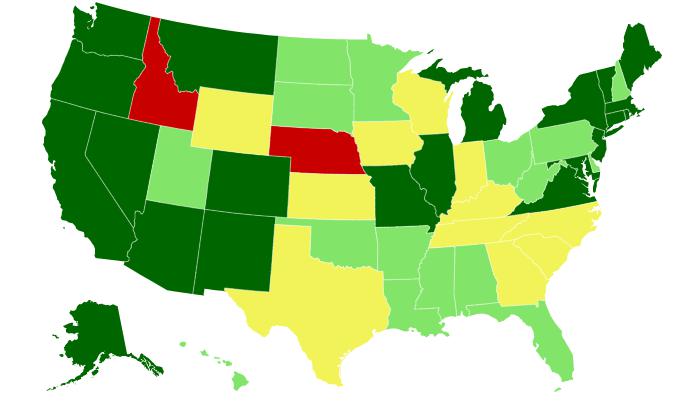

Marijuana is legal in 21 U.S. states, including one new red state. Here’s what it means for prohibition.
Only two out of five state ballot initiatives asking voters to legalize adult-use cannabis passed during the mid-term elections on Tuesday.
Voters in three of America’s conservative stronghold states— Arkansas, North Dakota and South Dakota—rejected ballot measures proposing adult-use marijuana legalization. Voters in Maryland and Missouri passed legalization initiatives. There are now 21 states that have legalized marijuana for adults 21 and older.
But, the so-called “green wave” seen during the November 2020 election, when four states voted to legalize adult-use and two, including Mississippi, voted to legalize medical marijuana, hit a wall this year.
“The 2022 mid-term elections were more controversial than we have seen in recent elections, as it relates to cannabis,” Vivien Azer, an analyst at Cowen, wrote in a memo published Wednesday.
Maryland and Missouri passing recreational marijuana is a significant event, but the states only comprise 3.8% of the adult population in the U.S. About 56% of voters in Arkansas rejected legalization, while nearly 55% of North Dakota voters and almost 53% of South Dakotans said no to pot. More than 65% of Maryland voters said yes to legalization and 53% of Missourians.
Paul Armentano, the deputy director of nonprofit marijuana legalization advocacy group NORML, says it’s a big deal that Maryland and Missouri, two states home to seven million Americans, “wisely chose to end the failed policy of prohibition.” He also pointed out that voters in cities across states like Texas and Ohio voted for municipal measures to decriminalize possession and use of marijuana.
“That’s a testament to the fact that this policy remains very popular and that the adoption of legalization in the growing number of states around the country has not given voters any reason to reconsider their decisions,” says Armentano.
The defeated ballot measures in Arkansas, and the Dakotas does not spell a repudiation of legalization, Armentano says. Two forces came together against the ballot measures, he says: all three states are Republican strongholds and voter demographics during mid-term elections are historically older and less progressive.
“Given those realities, these were always going to be difficult hurdles to climb, but they are not indicative of any sort of slowing down of momentum nationwide or buyer’s remorse among the American public in general,” says Armentano.
For Kevin Sabet, whose organization Smart Approaches to Marijuana fought to defeat each of the five ballot measures, Election Day was a win. He sees the rejection by voters as a sign that federal legalization is not a sure thing.
“We’re happy—it says marijuana legalization is not a foregone conclusion, it’s a deeply divisive issue,” says Sabet. “It can be defeated.”
In Arkansas, cannabis industry stake holders spent $14 million on Issue 4, while the opposition spent around $2 million. The opposition did have a secret weapon: the state’s political leaders were all against the initiative.
Arkansas Governor Asa Hutchinson, who served as the director of the Drug Enforcement Administration under President George W. Bush, led the state’s opposition to legalization, saying it was “the wrong direction for Arkansas.” Governor-elect Sarah Huckabee Sanders, who served as former President Donald Trump’s White House press secretary, also came out against it.
All three states that rebuked adult-use do have legal medical marijuana markets. Arkansas’ medical marijuana market generates $250 million in annual sales, according to Cowen, and North Dakota’s medical market is even smaller, with about $20 million in annual sales.
It was a surprise the ballot measure lost in South Dakota, which voted to legalize adult-use cannabis in 2020 but was later overturned by the Supreme Court. Azer called the initiative’s failure an “upset.”
Sabet says the failure of three out of five ballot measures should not be taken lightly. He believes it’s a sign that many Americans do not like the direction this country is going with legalization.
“I think it slows the green rush that we’ve seen happen and it shows that there are deep reservations in many parts of this country with the legalization of marijuana,” says Sabet. “This battle is far from over.”
Sabet, who founded Smart Approaches to Marijuana with former Congressman Patrick Kennedy, wants to “put the brakes” on the commercialization of marijuana, which he views as a new version of the tobacco industry.
“We want marijuana to be discouraged; today’s high potency marijuana is dangerous,” says Sabet. “We do not want to see us repeating the same mistakes we’ve seen with Big Tobacco. That’s what we’re so worried about in a lot of these states.”
While 68% of Americans support cannabis legalization, there are reservations. When asked what effect they think marijuana use has on society, 50% of Americans said it has had a negative effect while 49% said positive, according to a recent Gallup poll. Even though most mid-term voters in Arkansas, North and South Dakota voted “no” on adult-use, Azer points out that cannabis “has moved to penetrate deeper ‘red states’” with more than 40% of voters in each of those states voted to legalize weed. The fact that Missouri, a Republican state, voted yes on its adult-use ballot measure is a good indicator that marijuana legalization is bipartisan.
Next week, a bipartisan Congressional subcommittee will hold a hearing on cannabis decriminalization. Rep. Jamie Raskin, a Democrat from Maryland, and Rep. Nancy Mace, a Republican from South Carolina who introduced a bill to legalize marijuana, will host a hearing to examine the potential benefits of cannabis decriminalization at the federal level. The hearing will discuss racial disparities in marijuana enforcement and allowing the cannabis industry to better access the mainstream financial system.
For Armentano, the three losses are not indicative of a pullback in attitudes around legalization. “I don’t think anybody today is thinking that anything other than the wind continues to be at our back,” he says. “We have as much momentum as ever.”

